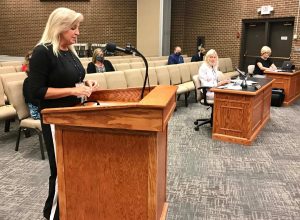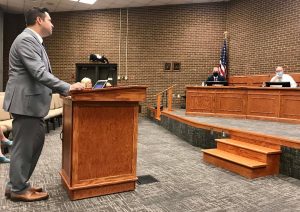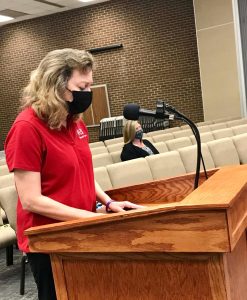
By Brandon Martin
Following the first month of instruction, the Henry County School Board heard an update on efforts by the schools to adapt to the new virtual learning environment.
“We are ending our fourth week of virtual instruction,” said Schools Superintendent Sandy Strayer. “One hundred percent virtual learning has been new to our teachers and for our families. I appreciate everyone’s patience and flexibility as we acclimate ourselves to our current learning environment. I cannot say thank you enough to our board, staff, parents and community for continuing to work hard to support all of our students.”
Strayer said that staff are reporting to work each day and are available to meet with parents or guardians who need assistance acclimating to the new structure. Additionally, she said staff are reporting in person to prepare for the transition to hybrid instruction.

David Scott, assistant superintendent for operations and administrative services, said “as far as enrollment, there are some ugly and undeniable truths that we have to acknowledge. Enrollment is down compared to last year. After the first month, we are down about 140 students compared to last year. Compared to the Department of Education projections for this year, we are down closer to 200 students.”
It’s not unusual for the average daily membership (ADM) to lag behind the membership count, according to Scott.
“In fact last year with hardly any change in membership in September, our ADM grew by 140 students in September, and another 50 or so in October,” he said. “It’s not out of the question that our ADM will rebound as it normally does during the fall. I do believe that we will still fall short of the Department of Education projection of 6,938 students but how much short is a difficult question to answer.”
Scott said that the drop in students could be attributed to multiple factors. Among them were out-of-state transfers, in-state transfers, private school transfers and families opting to homeschool.
“We will be mailing homeschooled families with detailed information about our online virtual offerings which we believe offer a more comprehensive learning experience than most homeschool programs, particularly in terms of counseling, academic support and the provision of meals,” Scott said. “While our home school numbers have not outpaced our numbers from last year, we do believe some families have chosen this option early this year before knowing how Henry County would return to school.”
One struggle with the virtual learning environment is ensuring that students are participating, Scott said.
“We know there are some not committing time to the task. We have those students every year, but when we have had the opportunities to interact with these parents and students, putting the devices in their hands and when they’ve allowed us to show them how online instruction will work, we have been able to re-enroll students,” he added.
There also is a plan to put an enforcement mechanism in place for families that are not cooperating.
Scott said that the schools plan on coordinating with social services agencies to pressure Temporary Assistance for Needy Families (TANF) recipients who aren’t participating in online learning.
“Now that we have delivered iPads and Kajeets to these families, and eliminated any excuse that they don’t have access to the instruction, we have to be able to put some responsibilities on the families not choosing to do the work,” Scott said.
Since state funds are reliant on enrollment numbers, any significant drop in numbers could affect the school system’s finances as well, he said.
Due to the uncertainty, Scott said that progress on capital projects would be evaluated with the potential of some delays “while we see how enrollment continues to fluctuate.”
In terms of actual instruction, Strayer said that teachers can use the learning management platform, Canvas, to ensure equity of instruction among students.
For students that miss Zoom calls with teachers, the lessons can be posted to Canvas to be watched later. Teachers and administrative staff have access to log onto Canvas and see if students have logged on to watch the sessions.
“We had every principal log on and report to” administrators “the number of students that are making no effort, not logging onto live Zoom calls and not going back to watch videos and turning work in. The numbers were small. It was a handful of students, so that was good news. I thought it was going to be a lot larger.”
Scott said that non-participation is an ever–present part of daily school life, regardless of virtual or in-person learning.
“To be realistic about it, and in a traditional setting, we have students that unfortunately show up to school every day and put forth no effort. So, to expect that that would be different in a virtual setting, I think is kind of foolish,” he said. “We know that we have students who rely on the school and consider themselves to be part of the school community who aren’t making an effort, but I can assure you that our teachers, our administrators are doing everything they can to get participation from those students.”
Assistant Superintendent of Teaching and Learning Lisa Millner said, “one thing that we needed to take advantage of with our CARES (Coronavirus Aid, Relief, and Economic Security) funding is a program called iCEV Curriculum.
“This helps our CTE (Career and Technical Education) courses since most of those courses are traditionally hands-on. This also provided an opportunity for those teachers to have that virtual curriculum at their fingertips, so that they could push out that same type of modules and learning experience to their students using the Canvas LMS (learning management system),” she said.
Following recent research, Millner said that there is an expectation that performance in mathematics will drop due to online learning. Working with outside partners, teachers learned how to use diagnostic performative assessments to identify instructional gaps and how to design instruction to address those gaps prior to learning new skills.
“If you hear anything about the diagnostic performative assessments, they are pretty much 4 to 6 questions that I would ask a student to complete and that would give me the data, kind of like a preassessment, of what I need to do to teach them in math,” Millner said.
Additionally, Millner said that 6.5 hours of learning in person does not translate to that much time online.
“Teachers are learning how to provide targeted instruction that doesn’t overwhelm students and families,” she said. “Principals are encouraging collaboration between teachers to divide and conquer. To share resources and lighten the load of teachers, students and families.”
Strayer said that one of the biggest complaints from parents has been finding assignments and figuring out how to submit assignments.
Principals were asked “to put on the main page of their Canvas page, where to find assignments and where to submit those. When there are concerns, we need to hear those so we can fix those.” Additionally, Strayer said that teachers and staff welcome phone calls as well.
Noting that some families are struggling due to a lack of Internet access, Director of Technology
Elizabeth Adkins said that after speaking with a representative from Xfinity, “at this time they provide internet essentials which provides qualifying families with internet for $9.95 a month. Sometimes the parents don’t qualify because they have an outstanding bill but between now and the end of December 2020. If families have an outstanding bill, they may still qualify for Internet essentials because they (Xfinity) are going to let the outstanding debt be waived. They also provide free internet hotspots. Families can go to wifi.xfinity.com to find the nearest free hotspot.”
Work is also being done to assist families outside of the service area for Xfinity.
“To begin the work on the internet expansion, I’m collecting addresses from schools and compiling a list,” Adkins said. She said a representative is going to start working with Xfinity’s “tech team to figure out the next expansion for our district that would help our students.”
Kajeets, or personal MiFis, also are being checked-out by students, according to Adkins.
“At this time, we’ve checked out approximately 175. We have a total of 388 that were purchased by the board of supervisors and they (families) are also making a monthly payment,” she said.
The data is limited daily, but refreshes every morning, Adkins said. The Kajeets also have firewalls in place to prevent students from accessing sites that aren’t appropriate or that are not related to instruction, like social media.
“This also preserves data,” she said. “We can run reports to see how the Kajeet is being used if we need to. For families that have more than two students, they have the option to check out more than one device.”
Adkins said that there has also been a delay in the delivery of iPads for 9th graders. The devices were supposed to arrive Aug. 18.
“We were told that it was due to the keyboard case. The 9th graders get a keyboard case which is different from what the 1-5th graders get, and that the case was on backorder,” Adkins said. She added that the school system is currently 6th in the queue for Apple’s shipping.
Scott also provided an update on the meals program, which totaled 27,000 meals during August. Because families have multiple food options under the current food service program, he said that it has made the operation “pretty clumsy at this point. We’ve had difficulty getting the right meals to families. We’ve had difficulty getting any meal for a student who is living out of zone. It’s difficult to coordinate those things in every special situation. However, with the passage of time, we are getting a lot better at that.”
With more families opting to take part in the school’s meal program, Scott said some added benefits have occurred.
“It allows our bus drivers to remain active and log hours to get paychecks, which also keeps our full cafeteria staff at work,” he said, and added that the next hurdle would be juggling delivery, pickup and in-school service of meals once students return to school.
Monica Hatchett, director of communications said that the schools have also distributed 366 food boxes.
“Each of these boxes contains between $100 and $150 worth of groceries, and includes items that students can prepare themselves, but also meals that families can make and enjoy together,” she said.
With money still left over from a grant, Hatchett said that another order to fill boxes will be put together in the coming week. Of the 366 boxes already distributed, Hatchett said that only 40 families have gotten more than one box. The rest of the distribution has been to new families.
In addition to food boxes, Hatchett said more time has been dedicated to communicating with families.
“We are talking to them by traditional methods, like over the phone and in person, but specifically through social media,” she said. “Our hours on Facebook, in particular, are” 5 a.m. until 11:30 p/m.
Hatchett said that a number of staff were recently involved with a “pandemic drill” involving Henry County Public Safety and members of the Department of Health.
“Coming out of that drill, we knew that we knew that we needed to enhance our communication with staff members about the protocols that we would follow,” she said, adding the division shared a protocol booklet with staff members recently so that staff are abreast of the right procedures.
“We also shared a letter with families to remind them how we will proceed once students return to school if there is an identified case in the building. And certainly, to remind them of our obligation and our desire to protect student information through HIPAA and FERPA,” she said of privacy laws.
Hatchett said the schools also are developing videos that will be posted to their websites for students and families “to know what to expect when we return back to school.”
When students do arrive back in school, sanitation efforts will be in full swing according to Keith Scott, director of facilities maintenance.
“Our Clorox-360 machines arrived about a month earlier than I thought they were,” he said. ”They are coming into play this week. We are going to start working on a training process next week, and distributing those to our schools so that also helps with our evening cleaning and being able to prepare for when our students arrive back as well.”
Keith Scott also said that the schools have more than enough disinfectant as well.
“The custodian refills those bottles as needed. We have plenty of those in stock and readily available if we need to order more,” he added.
Upgrades for the water fountains will also be made.
“We have the first round of bottle fillers. We have about 10 of the water cooler bottle fillers showing up next week and we will start installing those. We have a plan to start at the elementary schools, and then once those are complete to make sure each one has one, we will move into our secondary schools as well,” he said.
Strayer explained that the water bottle fillers prevent students from having to touch or put their lips on a water fountain.
Ben Gravely, of the Iriswood District, said he was impressed by the efforts being made, and called on the community to work with the schools.
“It seems like we are doing what we can do under these circumstances, and I guess my plea to the community is to be flexible along with us,” he said. “I think if we keep pushing, then I’m hoping the community is understanding about where we are in this process. We are working hard to try to meet their needs.”

A representative of the Virginia Education Association urged the school board to work in the best interest of teachers.
“Please allow teachers to work from home if they request to do so,” Alice Willingham said. “Many have discussed this option with their principals, and their administrators stated that they would allow for tele–work, but that site-based decision is not theirs to make. Please be certain that the decisions you make today do not become regrets later. In summary, teleworking options, a mask mandate and remote work assignments for high-risk employees would all be greatly appreciated,” Willingham said.




